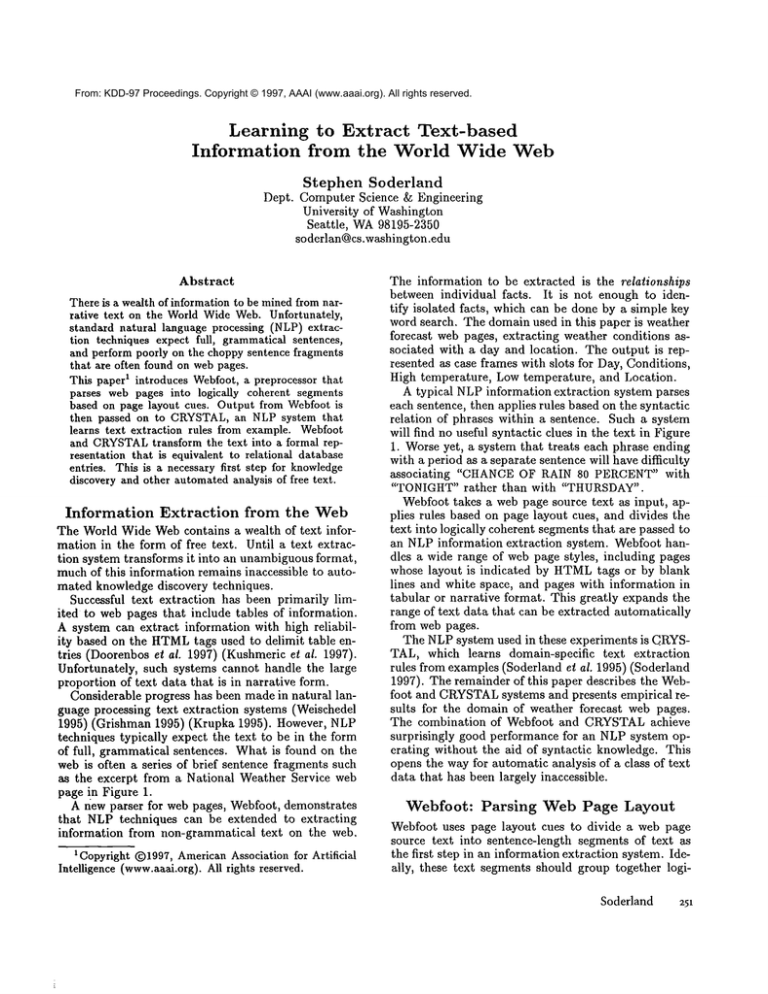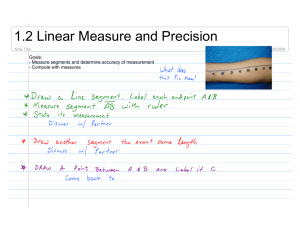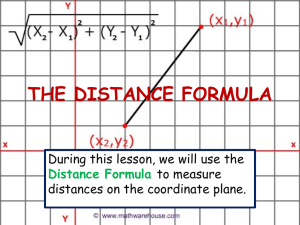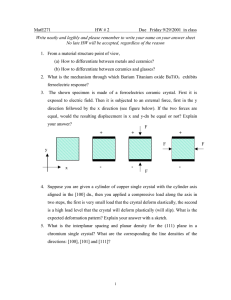
From: KDD-97 Proceedings. Copyright © 1997, AAAI (www.aaai.org). All rights reserved.
Learning
Information
to Extract Text-based
from the World Wide Web
Stephen Soderland
Dept. Computer Science ~ Engineering
University of Washington
Seattle, WA98195-2350
soderlan@cs.washington.edu
Abstract
There is a wealth of information to be minedfrom narrative text on the World Wide Web. Unfortunately,
standard natural language processing (NLP) extraction techniques expect full, grammaticalsentences,
and perform poorly on the choppy sentence fragments
that are often found on web pages.
This paper1 introduces Webfoot, a preprocessor that
parses web pages into logically coherent segments
based on page layout cues. Output from Webfootis
then passed on to CRYSTAL,an NLPsystem that
learns text extraction rules from example. Webfoot
and CRYSTAL
transform the text into a formal representation that is equivalent to relational database
entries. This is a necessary first step for knowledge
discovery and other automatedanalysis of free text.
Information Extraction from the Web
The World Wide Webcontains a wealth of text information in the form of free text. Until a text extraction system transforms it into an unambiguousformat,
muchof this information remains inaccessible to automated knowledge discovery techniques.
Successful text extraction has been primarily limited to web pages that include tables of information.
A system can extract information with high reliability based on the ttTMLtags used to delimit table entries (Doorenbos et ai. 1997) (Kushmeric et al. 1997).
Unfortunately, such systems cannot handle the large
proportion of text data that is in narrative form.
Considerable progress has been made in natural language processing text extraction systems (Weischedel
1995) (Grishman 1995) (Krupka 1995). However,
techniques typically expect the text to be in the form
of full, grammatical sentences. What is found on the
web is often a series of brief sentence fragments such
as the excerpt from a National Weather Service web
page in Figure 1.
A new parser for web pages, Webfoot, demonstrates
that NLPtechniques can be extended to extracting
information from non-grammatical text on the web.
1Copyright ©1997,AmericanAssociation for Artificial
Intelligence (www.aaai.org).All rights reserved.
The information to be extracted is the relationships
between individual facts. It is not enough to identify isolated facts, which can be done by a simple key
word search. The domain used in this paper is weather
forecast web pages, extracting weather conditions associated with a day and location. The output is represented as case frames with slots for Day, Conditions,
High temperature, Low temperature, and Location.
A typical NLPinformation extraction system parses
each sentence, then applies rules based on the syntactic
relation of phrases within a sentence. Such a system
will find no useful syntactic clues in the text in Figure
1. Worse yet, a system that treats each phrase ending
with a period as a separate sentence will have difficulty
associating
"CHANCEOF RAIN 80 PERCENT"with
"TONIGHT"rather than with "THURSDAY".
Webfoot takes a web page source text as input, applies rules based on page layout cues, and divides the
text into logically coherent segments that are passed to
an NLPinformation extraction system. Webfoot handles a wide range of web page styles, including pages
whose layout is indicated by IITMLtags or by blank
lines and white space, and pages with information in
tabular or narrative format. This greatly expands the
range of text data that can be extracted automatically
from web pages.
The NLPsystem used in these experiments is CRYSTAL, which learns domain-specific text extraction
rules from examples (Soderland et al. 1995) (Soderland
1997). The remainder of this paper describes the Webfoot and CRYSTAL
systems and presents empirical results for the domain of weather forecast web pages.
The combination of Webfoot and CP~YSTALachieve
surprisingly good performance for an NLPsystem operating without the aid of syntactic knowledge. This
opens the way for automatic analysis of a class of text
data that has been largely inaccessible.
Webfoot: Parsing Web Page Layout
Webfoot uses page layout cues to divide a web page
source text into sentence-length segments of text as
the first step in an information extraction system. Ideally, these text segments should group together logiSodedand
~1
<HEAD>
<TITLE>Forecast for NY072</TITLE>
</ItEAD>
<BODY>
<pre>
BRONX-KINGS
(BROOKLYN)-NASSAU-NEW
RICHMOND (STATEN IS.)300 PM EST WED FEB 26 1997
YORK
(MANHATTAN)-QUEENS-
.TONIGHT...CLOUDY
WITH OCCASIONAL LIGHT RAIN, LOW IN THE MID 40S.
WIND SOUTHWEST 10 TO 15 MPH. CHANCE OF RAIN 80 PERCENT.
.THURSDAY...MOSTLY
CLOUDY...WlNDY
AND MILD WITH A 30 PERCENT CHANCE
OF SHOWERS. HIGH 60 TO 65. WIND SOUTHWEST INCREASING TO 20 TO 30 MPH
WITH HIGHER GUSTS DURING THE AFTERNOON.
.THURSDAY NIGHT...PARTLY
CLOUDY. LOW 40 TO 45.
.FRIDAY...MOSTLY
SUNNY. HIGH 50 TO 55.
Figure 1: Source text from a National WeatherService forecast web page
cally related facts and should separate unrelated facts.
The notioll of a coherent text segment depends on
what facts and relationships are of interest to a given
domain. For weather forecast web pages, a segment
should include all the weather conditions related to a
given day as shownin Figure 2 and should not contain
multiple days or include conditions for other days.
Domain-independent delimiters:
Level 1
Level2
Level 3
Level4
Level 3p
<segment>
Field(l):
<HEAD> <TITLE> Forecast
Field(2):
</HEAD> <BODY>
</segment>
for
NY072 </TITLE>
Level 4p
<segment>
Field(l):
<pre>
Field(2): BRONX - KINGS ( BROOKLYN )- NASSAU
NEW YORK ( MANHATTAN )- QUEENS
RICHMOND ( STATEN IS.)Field(3): 300 PM EST WED FEB 26 1997
</segment>
<segment>
Field(l):
. TONIGHT...
Field(2):
CLOUDY WITH OCCASIONAL LIGHT
Field(3):
LOWIN THE MID 40S
Field(4):
WIND SOUTHWEST 10 TO 15 MPH.
Field(5):
CHANCE OF RAIN S0 PERCENT
</segment>
RAIN.
<’segment>
Field(l):
. FRIDAY...
Field(2):
MOSTLY SUNNY
Field(3):
HIGH 50 TO 55
</segment>
Figure 2: The sample text as segmented by Webfoot
Figure 3 summarizesthe tags and other text cues
that Webfootuses to delimit segments and to further
break segments into fields. This particular set of delimiters should be seen as a snapshot of a system under
development,rather than a fixed set of rules.
Webfootbegins by breaking the web page source text
into segments on level 1 delimiters. If a segment has
fewer than twenty words (not counting HTML
tags),
the higher level delimiters are used to break the segment into fields. If the segment has twenty or more
words, level 2 delimiters are used as segment breaks.
252
KDD-97
Level 3p
start: <html, <table, <ul, <pre>
end: </html>,
</table>,
</Ill>,
</pre>
start:<tr
end: </tr>
start:
<p>, <li>, <hr>, <br>S<br>
end: d/p>,
</li>,
</td>
start: <option, <liD
end: <br>, </hD>, </title>,
</th>,
".S"
start: line beginning with word(s) followed by ":",
line with tabs or multiple spaces
end: blank line,
line with fewer than 40 characters
end: ".S", tabs or multiple spaces
Weather forecast
Level 3p
domain delimiters:
start:
line with a weekday followed by ": ....
sentence beginning with a weekday,
line beginning with "."
S stands for whitespace,
-" or "...",
and D stands for digit
Figure 3: Delimiters used by Webfoot to parse web
page layout
If a segment still has more than twenty words, then
level 3 delimiters are used as segmentbreaks, otherwise as field breaks. In any case, level 4 delimiters are
used as field breaks. Pre-formattedsections and pages
without HTML
tags use delimiters 3p and 4p rather
than 3 and 4.
In addition to domain-independent rules, Webfoot
maybe tailored to the writing style of web pages in a
particular domainwith the addition of domain-specific
delimiters. Three additional delimiters were addedfor
the weather forecast domain to force a new segment
when a new day of the week was mentioned and for
a National WeatherService convention of beginning
bulleted items with a period.
CRYSTAL: Learning
Extraction
Rules
CI~YSTALis an NLPsystem that automatically induces a set of domain-specific information extraction
rules from traini,lg examples. The input to CFtYSTAL
is a set of instances that are produced by Webfoot
or some other sentence analyzer. Each instance is a
text segment, divided into fields. A syntactic analyzer
wouldlabel these fields as "subject", "verb", "object",
and so forth. Webfootsimply calls them "field".
An additional input to CRYSTAL
is a semantic lexicon used to look up the word sense of individual words
in the text. This allows CRYSTAL
to create rules that
apply to broad classes of words, which is critical for
leveraging broad coverage from a limited amount of
training. For the weather forecast domain, a semantic lexicon was created by hand consisting of 86 words
with the semantic class Weather_Condition ("cloudy",
"fair", "precipitation",
etc.) and 42 words with the
semantic class Time or Day.
CRYSTAL
rules, called concept definitions have a set
of constraints that apply to fields in an instance. These
may require the field to include particular semantic
classes or terms. A term may be a word, punctuation,
or HTMLtag.
Someof the fields in the concept definition are designated as extracting one or more slots of the target
concept. If all the constraints in a concept definition
are met, CRYSTAL
creates a case frame with fields of
the instance filling slots in the case frame as specified
in the concept definition.
Figure 4 shows a concept definition that was induced from a set of National Weather Service web
pages. This concept definition has constraints on
three fields. One field must include the semantic class
Weather_Condition and also a period. Another field
must include the semantic class Day and both a period and "...". A third field must include the word
"high" and a period. If all three constraints are met,
then CRYSTAL
extracts Conditions, Day, and High
from the fields indicated in the concept definitions.
Concept-type
Forecast
ID: 459
Status:
GENERALIZED
Constraints:
Field::
(extract
Conditions)
classes:
Weather_Condition
terms:
"."
Field::
(extract
Day)
classes:
Day
terms:
"" " "
Field::
(extract
High)
terms:
"HIGH", ","
Coverage: 94
Errors: 1
Figure 4: A CRYSTAL
concept definition
Conditions, and High
for Day,
CRYSTAL
uses a machine learning covering algorithm similar to Michalski’s AQalgorithm (Michalski
1983) and Clark and Niblett’s CN2algorithm (Clark
and Niblett 1989). It is a supervised learning method
that requires manually annotated training - texts in
which each reference to target concepts of the domain
has been tagged. CRYSTAL
begins with the most restrictive concept definitions that cover each positive
training instance. Concept definitions
alized by unifying similar definitions.
are then gener-
Empirical
Results
Webfoot and CRYSTALwere tested on a domain of
weather forecast web pages. Three weather sources
were tested that represent widely divergent styles of
web pages. The CNNWeather Service has automatically generated pages with extensive use of HTML
tags. The National Weather Service (NWS)presents
information in series of related sentence fragments, but
uses different page layout styles for different regional
weather centers. The Australian Bureau of Meteorology (Aus) has web pages without HTMLtags and with
no consistency in page layout for different regions. A
corpus of twenty web pages were annotated for each
weather service, two pages each from ten cities or regions.
The metrics used are recall and precision. Recall is
the percentage of positive instances that were identified by the system. Precision is the percentage correct
of the instances reported as positive. Rules for each
combination of case frame slots were tested separately.
If the rule base extracts this combinationof slots from
a test instance, and each extracted field has the appropriate annotation, this counts as one correct. If any
of the extracted fields lack the proper annotation, it
counts as an error.
Table 1 shows results for the weather forecast domain. These are averages of fifty random partitions
into 90%training and 10%blind test set. The columns
labeled NWS-1 and Aus-1 used Webfoot with only
domain-independent rules. For NWS-2 and Aus-2,
three domain-specific delimiters (tailored to NWS)
were added to Webfoot. CNN used only domainindependent rules.
The CNNweb pages have such a high regularity that
100%reliable rules can be learned from as few as two
training documents. The National Weather Service
pages are less rigidly formatted and present information in sentence fragments, but CRYSTAL
was able
to learn reliable rules that extract over 90%of the information with precision over 90%for combinations of
slots that include weather conditions.
Webpages from Australia were so varied that training from one weather station was often little help in
learning rules for another weather station. For higher
performance, the training data should include multiple
pages for each weather station in the test set.
Extracting information about Location showed the
lowest performance.
CRYSTALwas provided with
a semantic lexicon for words with semantic class
Weather_Condition, Time, or Day, but there was no
corresponding list of city names and geographical
terms. CRYSTAL
can compensated for this somewhat
by learning location names one at a time as term constraints, if the training mentions a location multiple
times.
Soderland
253
Table 1: Performance
in the Weather Forecast
Concept
Day,Conditions,High,Low
Day, Conditions,High
Day,Conditions,Low
Day,Conditions
Day,Location
Location
% Correct
Segments
% Lump errors
% Split errors
CNN
Rec
Pre
100.0
100.0
100.0
100.0
100.0
1O0.0
100.0
100.0
100.0
100.0
100.0
100.0
100,0
0.0
0.0
Domain
NWS-1
Rec
Pre
28.0
5.0
18.6
25.4
9.3
15.1
21.1
64.0
50.2
44.8
55.5
49.4
20.9
79.1
0.0
Table 1 also shows tile percentage of correct
segmentation 2 for each of the weather sites and each
version of Webfoot. "Lumperrors" are when unrelated
information or multiple days’ weather is included in the
same segment. "Split errors" are when related information is split between two or more segments. Without
the domain-specific rules, Webfootoften ran together
entries for multiple days, especially in NWS
web pages.
This had a serious impact on recall and precision.
Conclusions
Webfoot and CRYSTAL
allow automatic information
extraction from a class of web page text data that has
been largely inaccessible to automated systems. Text
in non-grammatical sentence fragments as well as text
in tabular format are parsed by Webfoot into coherent text segments based on page layout cues. CRYSTALtllen learns domain-specific rules for information
extraction. High performance can be obtained even
though CRYSTAL
was originally designed to rely on
syntactic iuformation within full sentences.
Extraction rules for highly structured tables can be
learned from as few as two training documents. The
performance of Webfoot on this domain suggests that a
set of domain-independentrules are sufficient to parse
web pages that make extensive use of HTML
tags.
Free text narrative and web pages without HTML
tags pose a harder problem, and require several annotated training examples for each web site. Webfoot
may need a small number of domain-specific rules, such
as those testing for days of the week to begin a new
segment in weather forecast pages. In addition, CRYSTALneeds a semantic lexicon that lists words of semantic classes relevant to the domain.
Webfoot and CRYSTAL
create a formal representation of the text that is equivalent to relational database
entries. This provides unambiguousinput to later processing, such as classifying individual texts, summarizing data from a large collections of texts, and discovering trends and relationships that span texts. The current experiments are limited to developing and testing
the text extraction tools. The next step is to incorporate Webfoot and CRYSTAL
as components in a full
knowledgediscovery application.
2of segmentscontaining relevant information
254
KDD-97
NWS-2
Rec
Pre
90.3
95.9
92.0
95.4
90.7
92.6
96.5
92.1
59.1
97.0
97.0
63.1
98.3
1.7
0.0
Aus-1
Rec
Pre
52.0
94.0
83.3
26.9
67.3
95.3
34.6
83.3
23.1
56.4
23.8
81.4
81.8
14.9
3.3
Aus-2
Rec
Pre
85.5
34,1
63,0
88.3
47,1
94.2
46,3
83.2
18.3
64.9
17,2
75.0
95.8
0.9
3.3
Acknowledgments: This research was funded in part
by Office of Naval Research grant 92-J-1946, by ARPA/
RomeLabs grant F30602-95-1-0024,by a gift from Rockwell International Palo Alto Research, and by National Science Foundation grant IRI-9357772. CRYSTAL
was provided by the NLPLaboratory, University of Massachusetts
Computer Science Department, Amherst, Massachusetts.
Copyright 1990-1996 by the Apphed Computing Systems
Institute of Massachusetts, Inc. (ACSIOM).
References
Doorenbos, R., Etzioni, O., and Weld, D. A Scalable Comparison-Shopping Agent for the World-Wide
WebIn Proceedings of the First International Conference on Autonomous Agents, 39-48, 1997.
Clark, P. and Niblett, T. The CN2Induction Algorithm. Machine Learning, 3,261-283, 1989.
Grisllman,
1%. The NYU System for MUC-6 or
Where’s the Syntax? In Proceedings of the Sixth Message Understanding Conference, Morgan Kaufinann
Publishers, 167-175, 1995.
Kushmerick, N., Weld, D., Doorenbos, R. Wrapper
hlduction for Information Extraction. In Proceedings
of the Fifteenth bzternational Joint Conference on
Artificial Intelligence, 1997.
Michalski, R. S. A Theory and Methodology of Inductive Learning. Artificial h~telligence, 20, 111-161,
1983.
Soderland, S., Fisher, D., Aseltine, J., Lehnerr, W. CRYSTAL:Inducing a Conceptual Dictionary. In Proceedings of the Fourteenth International
Joint Conference on Artificial Intelligence,
13141321, 1995.
Soderland, S. Learning Text Analysis Rules for
Domain-specific Natural Language Processing. Ph.D.
thesis, technical report UM-CS-1996-087University
of Massachusetts, Amherst, 1997.
Krupka, G. SRA: Description of the SRASystem as
Used for MUC-6.In Proceedings of the Sixth Message
Understanding Conference, Morgan KaufmaIm Publishers, 221-236, 1995.
Weischedel, K. BBN: Description of the PLUMSystem as Used for MUC-6.In Proceedings of the Sixth
Message Understanding Conference, Morgan KaufmannPublishers, 55-70, 1995.





